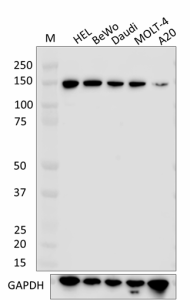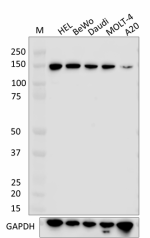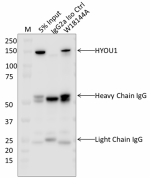- Clone
- W18144A (See other available formats)
- Regulatory Status
- RUO
- Other Names
- Hypoxia Up-Regulated 1, GRP-170, ORP-150, 170 kD Glucose-Regulated Protein 150 kD Oxygen-Regulated Protein
- Isotype
- Rat IgG2a, κ
- Ave. Rating
- Submit a Review
- Product Citations
- publications

-

Whole cell extracts (15 µg) from the indicated cell lines were resolved by 4-12% Bis-Tris gel electrophoresis, transferred to a PVDF membrane and probed with 1.0 µg/mL (1:500 dilution) of purified anti-HYOU1 antibody, clone W18144A, overnight at 4°C. Proteins were visualized by chemiluminescence detection using HRP-conjugated goat anti-rat IgG antibody (Cat. No. 405405) at a 1:3000 dilution. Direct-Blot™ HRP anti-GAPDH antibody (Cat. No. 607904) was used as a loading control at a 1:50000 dilution (lower). Lane M: Molecular Weight marker. -

Whole cell lysates (250 µg) were prepared from MOLT-4 cells and then immunoprecipitated overnight with 2.5 µg of purified rat IgG2a, κ isotype control antibody (Cat. No. 400502) or purified HYOU1 antibody (clone W18144A). The resulting IP fractions and 5% whole cell lysate input were resolved by 4-12% Bis-Tris gel electrophoresis and probed with HRP-conjugated goat anti-rat IgG antibody. -

HeLa cells were fixed with 4% paraformaldehyde for 10 minutes, permeabilized with Triton X-100 for 10 minutes, and blocked with 5% FBS for 60 minutes. Cells were then intracellularly stained with a 1:500 dilution (1.0 µg/mL) of either purified rat IgG2a, κ isotype control antibody (Cat. No. 400502, Panel A) or purified anti-HYOU1 antibody, clone W18144A (Panel B) overnight at 4°C, followed by incubation with Alexa Fluor® 594 goat anti-rat IgG antibody (Cat. No. 405326) at 2.0 µg/mL. Nuclei were counterstained with DAPI, and the image was captured with a 60X objective.
| Cat # | Size | Price | Save |
|---|---|---|---|
| 671401 | 25 µg | ¥22,220 | |
| 671402 | 100 µg | ¥55,660 |
HYOU1 belongs to the heat shock protein 70 family. The protein encoded by this gene is involved in stress-dependent induction. As a result, under low-oxygen conditions, HYOU1 accumulates in the endoplasmic reticulum. HYOU1 also acts as a nucleotide exchange factor (NEF) that recognizes other proteins within the ER and participates in protein folding.
Product DetailsProduct Details
- Verified Reactivity
- Human, Mouse
- Antibody Type
- Monoclonal
- Host Species
- Rat
- Immunogen
- Partial recombinant human HYOU1 protein corresponding to amino acids 750-999.
- Formulation
- Phosphate-buffered solution, pH 7.2, containing 0.09% sodium azide.
- Preparation
- The antibody was purified by affinity chromatography.
- Concentration
- 0.5 mg/ml
- Storage & Handling
- The antibody solution should be stored undiluted between 2°C and 8°C.
- Application
-
WB - Quality tested
ICC, IP - Verified - Recommended Usage
-
Each lot of this antibody is quality control tested by Western blotting. For Western blotting, the suggested use of this reagent is 0.05 - 1.0 µg per ml. For immunocytochemistry, a concentration of 1.0 μg per ml is recommended. For immunoprecipitation, the suggested use of this reagent is 2.5 µg per ml. It is recommended that the reagent be titrated for optimal performance for each application.
- Application Notes
-
When stained for ICC, methanol permeabilization proved more effective than Triton-X 100 permeabilization in localizing expression to the endoplasmic reticulum.
- RRID
-
AB_2814532 (BioLegend Cat. No. 671401)
AB_2814532 (BioLegend Cat. No. 671402)
Antigen Details
- Structure
- HYOU1 is a 999 amino-acid protein with a predicted molecular weight of 110 kD.
- Distribution
-
Localized to the ER; Ubiquitously expressed
- Function
- Protein folding & secretion; stress-dependent induction
- Molecular Family
- Heat Shock Proteins, Organelle Markers
- Antigen References
-
- Ozawa K, et al. 1999. J. Biol. Chem. 274(10):6397-404.
- Ikeda J, et al. 1997. Biochem. Biophys. Res. Commun. 230(1):94-9.
- Takeuchi S. 2006. Protein J. 25(7-8):517-28.
- Kaneda S, et al. 2000. J Biochem. 128(3):529-38.
- Gene ID
- 10525 View all products for this Gene ID
- UniProt
- View information about HYOU1 on UniProt.org
Related Pages & Pathways
Pages
Other Formats
View All HYOU1 Reagents Request Custom Conjugation| Description | Clone | Applications |
|---|---|---|
| Purified anti-HYOU1 | W18144A | WB,IP,ICC |
Compare Data Across All Formats
This data display is provided for general comparisons between formats.
Your actual data may vary due to variations in samples, target cells, instruments and their settings, staining conditions, and other factors.
If you need assistance with selecting the best format contact our expert technical support team.










Follow Us